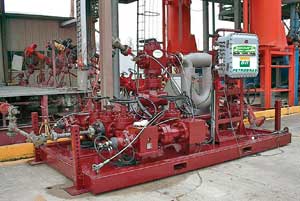| Vol. 227 No. 12 |
 |
Rig floor equipment
Drilling control system regulates backpressure
The Secure Drilling Micro-Flux Control System is a closed-loop system that collects and analyzes commonly available drilling data to detect well kicks or loss of circulation, and, if desired, automatically manages applied backpressure to control kicks.
The required manifold and control equipment is integrated and compact, and the system works in parallel with existing rig well-control equipment. The present system employs one skid containing the chokes, choke actuators, flow meter and a data acquisition and control processor. In addition to the skid, there is a remote interface that allows the operator (driller) to view activity and interact with the system. The system can be installed on virtually any onshore, jackup or floating rig, and can be used with water-, oil- and synthetic-based muds.
The system uses real-time drilling data inputs from: flow rates in and out of the wellbore; mud density in and out; standpipe pressure; surface backpressure (measured upstream from the drilling choke) and choke position. Based on the flow and pressure data received and analyzed, the system detects any discrepancy between the expected and actual return flow, which is confirmed with pressure and flow measurements, and identifies influx or loss with very low volumes in gallons rather than barrels. Once an influx is detected, and depending on the mode selected by the operator, the system can automatically apply or reduce backpressure via electronically-controlled chokes, to correct or mitigate the event.
 |
The Micro-Flux Control System detects discrepancies between expected and actual return flow, automatically applying or releasing backpressure to mitigate an event.
|
|
The closed loop can routinely detect an influx at 1/10 to 3/10 bbl and the system creates backpressure automatically to stop the flow from the formation, and then holds that back pressure until the influxes are circulated out.
Detection of a small fluid gain or loss initiates immediate action, such as closing the chokes to increase the bottomhole pressure of the well, if an influx is detected, or displaying alert messages when a loss is confirmed. The central data acquisition and control system collects and processes the data and directs the actions required of the choke – opening or closing it – to respond to the event.
The technology’s unique feature is its ability to measure the return fluid flow using a flowmeter installed just downstream of the chokes, as well as detect and react to either a fluid gain or loss in the very early stages of an event. Immediate response from the system allows loss or gain volumes to be kept as small as possible – thus, the micro-flux control method.
The system can be turned on and off with the flip of a virtual switch, and becomes invisible to the drilling process, if the driller decides for any reason to return to conventional drilling or well-control operations.
The driller and other rig personnel can be easily trained by Secure Drilling technical staff. It is envisioned that the system will ultimately require no extra personnel. Until that occurs, expert technical personnel are available to install and operate the systems worldwide.
The Secure Drilling System, five years in development, was first deployed in August 2006 for Petrobras in Brazil and has already been used on four wells of varying difficulty both on- and offshore. The challenging deepwater arena is where the system can significantly change economics by providing a safer and more efficient drilling method. Additional jobs are scheduled in Europe and the Middle East in the first and second quarters of 2007. 
|




